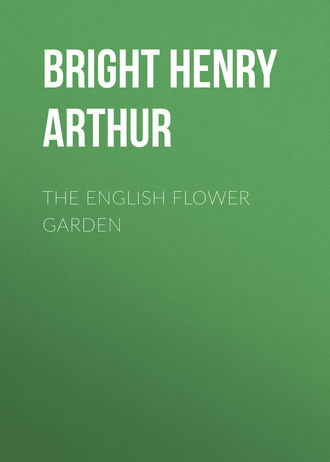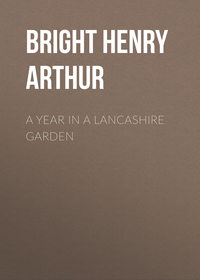 полная версия
полная версияThe English Flower Garden
I believe it is now pretty well ascertained that the Œnothēra of the ancients was the small Willow-herb (Epilobium roseum), which in my own garden is the most familiar of weeds.
Pliny describes it as having exhilarating properties in wine, as having leaves like those of the Almond-tree, a rose-coloured flower, many branches, and a long root, which, when dried, has a vinous smell, and an infusion of which has a soothing effect on wild beasts.
In Baptista Porta’s curious Phytognomonica (published at the end of the sixteenth century) he says, – speaking no doubt of this same Epilobium, – that the dried root of the Œnothēra smells of wine; given as a drink it soothes wild beasts and makes them tame, and rubbed on the worst wounds it serves to heal them.
NOTE V
THE CHRISTMAS ROSEThe Christmas Rose is certainly one of the most valuable of flowers, but it is a little capricious, growing luxuriantly in one place, and in another gradually dwindling off. With me it is always successful, and one secret may be that the roots are never allowed to be disturbed. This beautiful flower has rather weird associations. It is the Black Hellebore of Pliny, and was used as a poison and in incantations. Spenser plants it with the “dead sleeping poppy” and all other sad and poisonous herbs in the garden of Proserpina. Often, however, it was valued for its medicinal qualities, and was occasionally, we are told, made use of by literary people for the purpose of sharpening up their intellects. Gerard says that “Black Hellebore is good for mad and furious men, for melancholike, dull, and heavie persons, for those that are troubled with the falling sickness, for lepers, for them that are sicke of quartaine ague, and briefly for all those that are troubled with blacke choler, and molested with melancholie.” Cowley, too, has a curious poem, in which the Christmas-flower (as he calls it) speaks, and boasts that, alone of flowers, Winter “still finds me on my guard,” though the ground is “covered thick in beds of snow,” and then it sounds its triumphs over all sorts of ills, physical and mental:
“I do compose the mind’s distracted frame,A gift the gods and I alone can claim.”Old Dr. Darwin, in his Loves of the Plants, has a scientific interest of quite another kind in the Christmas Rose:
“Bright as the silvery plume, or pearly shell,The snow-white rose, or lily virgin bell,The fair Helleboras attractive shone,Warmed every Sage, and every Shepherd won,”but, when the seed-vessel begins to swell,
“Each roseate feature fades to livid green.”He adds, in a note, that “The Helleborus niger, or Christmas Rose, has a large beautiful white flower, adorned with a circle of tubular two-lipp’d nectaries. After impregnation the flower undergoes a remarkable change, the nectaries drop off, but the white corol remains, and gradually becomes quite green. This curious metamorphose of the corol, when the nectaries fall off, seems to show that the white juice of the corol were before carried to the nectaries for the purpose of producing honey, because, when these nectaries fall off, no more of the white juice is secreted in the corol, but it becomes green, and degenerates into a calyx.”
Dr. Darwin’s theory may or may not be strictly accurate, but his observation of facts is certainly undoubted.
In one of Keats’s early poems he notices the Hellebore’s curving leaf,
“As the leaves of HelleboreTurn to whence they sprung before,And beneath each ample curlPeeps the richness of a pearl!”But if poets know how to describe a Christmas Rose, there are others who do not. A horticultural book just published, says – and the description is a curiosity – that in the month of January, “in our garden, on the hillside, the Christmas Rose is the sweetest and prettiest thing to show. Its petals are weak and pale; its perfume is very faint; if you gather it, the leaves presently fall off, and the flower is destroyed. Leave it in the hedge, when it is almost the only thing to gladden the eye:
“The Christmas Rose, the last flower of the year,Comes when the holly berries glow and cheer —When the pale snowdrops rise from the earth,So white and spirit-like ’mid Christmas mirth.”I wish the writer would show me this curious Christmas Rose, which grows in a hedge, and has weak petals and a faint perfume, and is spirit-like! What can it be? and who could have written these very unmelodious lines?
THE END1
See Note I., on the Gardener Bower-bird.
2
See Note II., on Ars Topiaria.
3
Horace Walpole says that Bridgeman invented the sunk fence, “and the common people called them ‘Ha! ha’s!’ to express their surprise at finding a sudden and unperceived check to their walks.” He adds that Kent “leaped the fence, and saw that all Nature was a garden.”
4
See Note III., on a Poet’s Flower-bed.
5
In Gleanings from French Gardens, and Alpine Flowers for English Gardens.
6
I have just seen the following hopeful advertisement:
7
See Note IV., on the Evening Primrose.
8
See Note V., on the Christmas Rose.
9
I have adopted Professor Amos’s translation.


